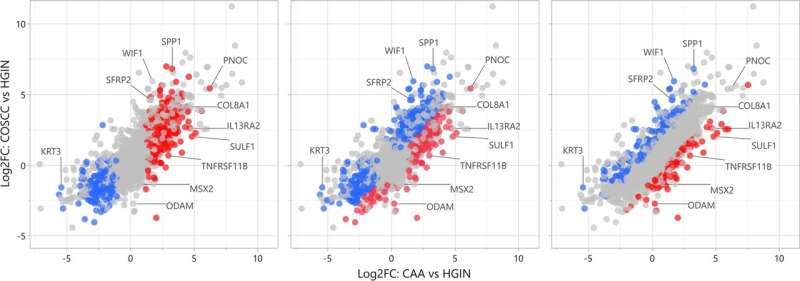Scatterplots showing patterns of differential gene expression in CAA and COSCC according to log2-fold change (Log2FC) values relative to HGIN. Each point, regardless of color, corresponds to an individual gene; only expressed genes are depicted. The eleven labeled genes correspond to those that were used for qPCR validation assays. The three panels differ only by coloration of individual genes. Panel (A) shows 783 genes that were found to be significantly upregulated (red) and 412 that were downregulated (blue) in CAA compared to HGIN when applying stringent differential expression criteria. The colored (red and blue) points in panel B depict 1507 genes that were found to be differentially expressed in one or both tumors when compared to HGIN (i.e., CAA vs HGIN or COSCC vs HGIN), with red points corresponding to those that were upregulated in CAA versus COSCC, and blue points corresponding to those that were downregulated in CAA versus COSCC. Panel C shows 142 genes that were significantly upregulated (red) and 272 genes that were significantly downregulated (blue) in CAA versus COSCC regardless of how they compared to HGIN. Abbreviations: HGIN healthy gingiva, OSCC canine oral squamous cell carcinoma, CAA canine acanthomatous ameloblastoma. Credit: DOI: 10.1038/s41598-021-97430-0
Recent Cornell research compared the genetic expression profiles of a nonlethal canine tumor and the rare, devastating human oral tumor it resembles, laying the groundwork for potential translational medicine down the road.
While canine acanthomatous ameloblastoma (CAA) is common and nonlethal, it has a strong resemblance to an oral tumor in humans known as ameloblastoma (AM).
As a boarded veterinary dentist and oral surgeon, Dr. Santiago Peralta, associate professor at the College of Veterinary Medicine (CVM) and first author of the recent study in Scientific Reports, sees CAA in his clinic all the time.
"This research was a good example of a full cycle of translational research," Peralta said. "We took something we were dealing with in the clinical setting, studied it in the bench setting and are now hoping to use it to help veterinary patients and, potentially, humans."
The resemblance between CAA and AM had long been noted by scientists and clinicians, but no one had confirmed any molecular similarities. A previous study on AM tumors revealed the underlying mutations, piquing the interest of Peralta and his CVM colleagues. "We wondered if we should look at these mutations and see if they precipitate the canine tumor," Peralta said.
They did just that, publishing a study in Veterinary and Comparative Oncology in 2019, that revealed that both AM and CAA shared mutations in a well-known signaling pathway, known as the RAS-RAF-MAPK pathway.
In their most recent study, Peralta and his colleagues analyzed a large genomic dataset generated by the Cornell Transcriptional Regulation and Expression Facility (TREx) to better understand the biological consequences of these mutations. While doing so, they compared the CAA tumors with another common canine tumor (oral squamous cell carcinoma) and healthy gum tissue. These samples were stored and made available through the Cornell Veterinary Biobank and gene expression was profiled with RNA sequencing by Dr. Jen Grenier and her team at TREx.
The team also used genomic data from human tissues to run comparisons, thanks to their collaboration with a human oral cancer expert at the University of Turku in Finland. Through analyzing these different tissues, Peralta and his team were able to see that the mutations they had identified in their earlier study were largely responsible for the tumors they were seeing.
They also found that CAA and AM are very similar at a molecular level, reinforcing the notion that dogs represent a potentially useful natural model of the human tumor. "All the dysregulated molecules and pathways in CAA tumor tissues were consistent with the mutations we'd found and remarkably similar to those observed in AM," he said.
Now that they've connected the dots between the underlying mutations and dysregulated molecular pathways driving tumor formation, Peralta and his colleagues have been working to establish in vitro and in vivo models of different canine oral tumors that can be used to test potential drugs. Any drugs that might prove effective in treating oral tumors in dogs could also be promising candidates for human patients with analogue disease.
"If dogs truly represent a useful clinical model of the disease, they also represent an immense opportunity," Peralta said. Because the CAA tumors are much more common in dogs than AM are in humans, scientists can rapidly enroll many more dogs in clinical trials and get more translatable data from those trials.
Furthermore, dogs, which live in same type of environments as humans, are more accurate models of disease than other animal models. "My goal as a veterinarian is to bring solutions back to the clinic. We're not there yet, but we've made a major step toward that," Peralta said.
More information: Santiago Peralta et al, Comparative transcriptional profiling of canine acanthomatous ameloblastoma and homology with human ameloblastoma, Scientific Reports (2021). DOI: 10.1038/s41598-021-97430-0
Journal information: Scientific Reports
Provided by Cornell University
























